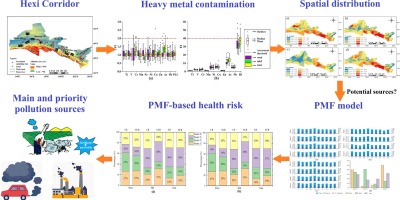Catena ( IF 6.2 ) Pub Date : 2020-03-26 , DOI: 10.1016/j.catena.2020.104573 Feifei Wang , Qingyu Guan , Jing Tian , Jinkuo Lin , Yanyan Yang , Liqin Yang , Ninghui Pan

|
To determine the heavy metal contamination of agricultural soil in the Hexi Corridor, 376 soil samples were collected and analyzed for their heavy metal content. The geochemical baseline value (GBV), single-factor pollution index (PI), ecological risk of a single heavy metal, and comprehensive ecological risk index (RI) were used to assess the degree of pollution. Geostatistical analysis, positive matrix factorization (PMF), and a health risk assessment model were used to determine the primary sources of pollution and priority sources. Although the mean Ti, V, Cr, Mn, Fe, Ni, Cu, Zn, As, and Pb concentrations (2717, 62.85, 48.23, 511.6, 24827, 51.29, 26.47, 53.98, 12.39, 16.85 mg•kg−1 in the west, 3046, 72.15, 59.32, 598.1, 27614, 54.57, 29.55, 59.47, 13.63, 20.74 mg•kg−1 in the center, and 2558, 61.02, 39.67, 466.7, 22575, 39.94, 26.06, 54.81, 11.86, 20.38 mg•kg−1 in the east, respectively) did not exceed the national critical values, approximately 1% of the west As samples did exceed their critical values. The mean concentrations of the heavy metals were less than their corresponding GBVs. The PI and RI revealed that the agricultural soil was moderately polluted, at low ecological risk, and the least polluted in the center. Based on PMF, Factor 1 represented metal processing; Factor 2 represented the mixed sources of electroplating and smelting in the west and center, and the mixed sources of mining and agricultural activities in the east; Factor 3 was ascribed to agriculture; and Factor 4 was the mixed sources of atmospheric deposition and traffic emission. The main pollution source, Factor 4 in the west and east and Factor 2 in the center, had the highest percent proportion of total metals and priority pollution sources, thus contributing the most to the carcinogenic (Factor 2 in the west and Factor 3 in the center and east) and non-carcinogenic risks (Factor 2 for adults and Factor 1 for children in the west and Factor 3 in the center and east), respectively.
中文翻译:

河西走廊农业土壤中重金属的污染特征,污染源分配及健康风险评估
为了确定河西走廊农业土壤中的重金属污染,收集了376个土壤样品并分析了它们的重金属含量。用地球化学基准值(GBV),单因素污染指数(PI),单一重金属的生态风险和综合生态风险指数(RI)评估污染程度。地统计分析,正矩阵分解(PMF)和健康风险评估模型用于确定污染的主要来源和优先来源。尽管平均Ti,V,Cr,Mn,Fe,Ni,Cu,Zn,As和Pb浓度(2717,62.85,48.23,511.6,24827,51.29,26.47,53.98,12.39,16.85 mg•kg -1 in西,3046,72.15,59.32,598.1,27614,54.57,29.55,59.47,13.63,20.74 mg•kg -1在中心,和2558、61.02、39.67、466.7、22575、39.94、26.06、54.81、11.86、20.38 mg•kg -1分别在东部)没有超过国家临界值,大约是西方的1%,因为样本确实超过了其临界值。重金属的平均浓度小于其对应的GBV。PI和RI显示,农业土壤受到中度污染,生态风险低,且中心污染最少。基于PMF,因子1代表金属加工;因子2代表了西部和中部的电镀和冶炼混合来源,而东部则代表了采矿和农业活动的混合来源。因素3归因于农业;因子4是大气沉积和交通排放的混合源。主要污染源,西部和东部为因子4,中心为因子2,


























 京公网安备 11010802027423号
京公网安备 11010802027423号